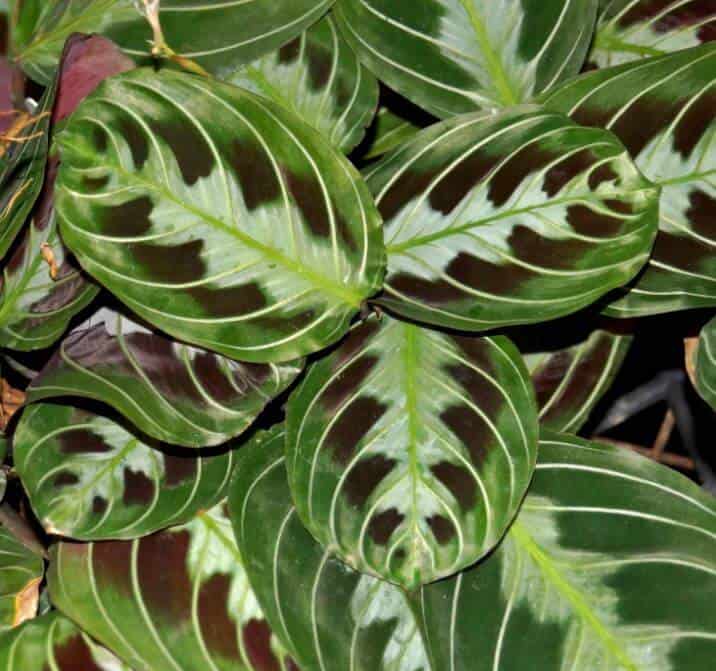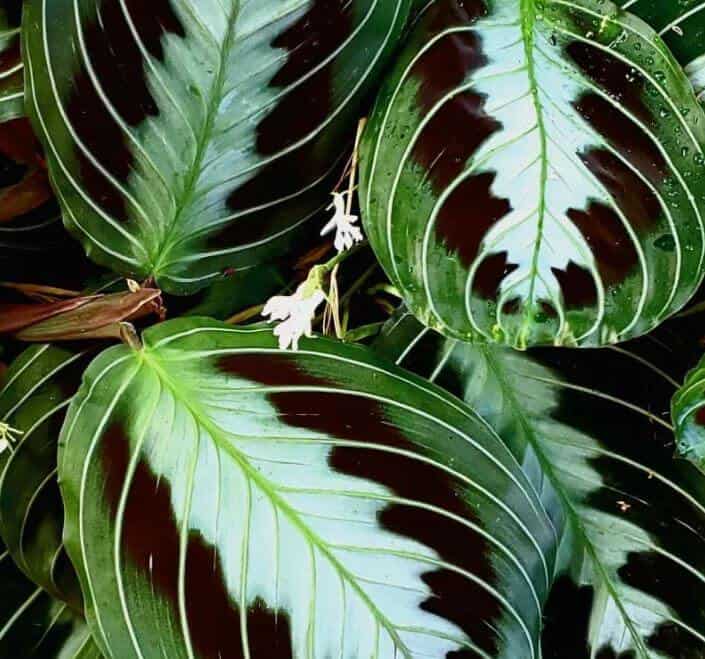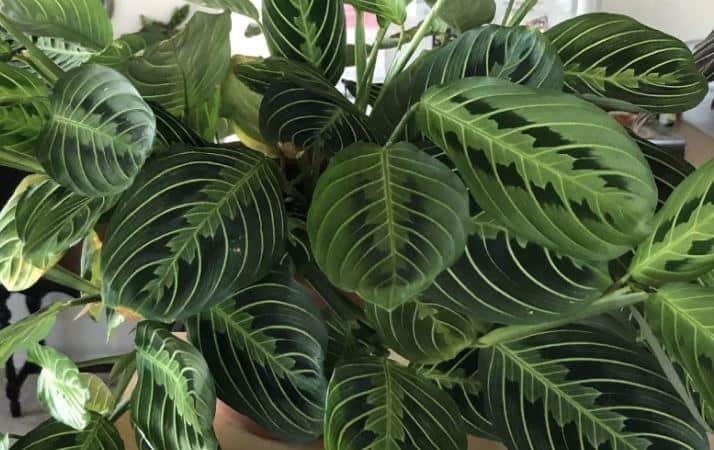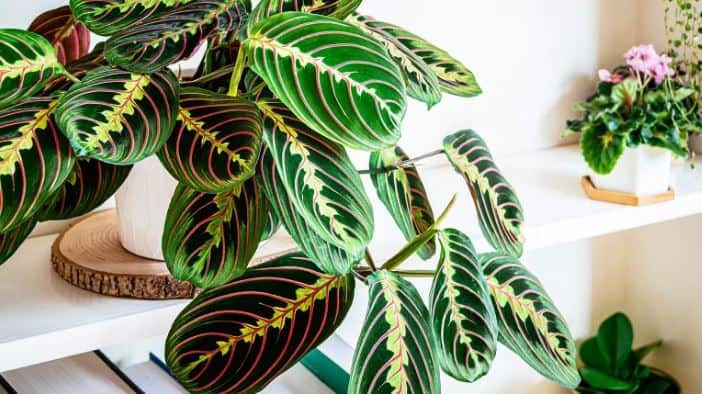Last Updated on January 7, 2023 by a Friendly Gardener
Botanically known as the Maranta leuconeura massangeana, the Black Maranta is also often referred to as a “Prayer Plant”. This is because as evening arrives leaves rise into a vertical position that appears as if a pair of hands are folded in prayer. During the daytime, leaves open entirely and lay flat. An herbaceous perennial that is a native of Brazil, this plant is named for the 16th-century Italian medical doctor and botanist Bartolomeo Maranta.
The Black Maranta distinguishes itself for its lovely large oval-shaped foliage which features a central silver vein immersed in a hue of rich purplish black. Silvery stripes extend from the leaf center to lovely green edges. Every leaf is unique on this plant and will be slightly different than the other foliage. The Black Maranta flowers in the spring produce smallish white blooms, however, flowering is rare when the plant is cultivated indoors.
Despite their slow growth, they can reach roughly a foot in height and in width with indoor cultivation. Outdoors they can be cultivated in USDA hardy zones 11 and 12.
Are the Maranta and the Calathea the Same Plant?
No, while the popular name of “Prayer Plant” is often applied to both, these are two distinct plants. The Marantaceae plant family includes Calathea, so they are related.
Black Maranta Plant Care

While caring for a Black Maranta Prayer plant is not difficult, its specific environmental needs must be met. As a tropical plant, it needs humidity, moderate temperatures, and sufficient water. Their ideal environment will resemble that of a greenhouse. They do not tolerate extreme temperatures. In excessive heat, the foliage turns dark, whereas, in colder temperatures, leaves will easily be damaged. If you can provide an environment like their native habitat, there are easy plants to care for.
Soil
The Black Maranta should have a container that is wide and shallow with drainage holes. The root system is shallow and thin, making it a bit delicate and susceptible to root rot. Hence, the soil needs to be well draining. Blend one part quality potting mix with two parts peat moss, and one part sand or perlite to ensure drainage capabilities. Soil should have a pH that is slightly acidic measuring 6. You can add a layer of rocks or gravel to the bottom of the container to guarantee adequate drainage.
Light
The Black Maranta will tolerate low light environments, but leaves may not open completely if the plant receives inadequate light. The Maranta should not be exposed to direct sunlight as this can scorch leaves as well as fade their intense coloring. Very bright indirect light is best. In winter, it’s important that the available light maintain the same intensity as the rest of the year otherwise your plant will enter dormancy and may do back entirely. A spot near a window is recommended or supplement light with a grow light.
Water
Black Marantas require generous watering. The soil bed should always remain moist but should not be soggy. When watering, use tepid or warm water. Watering can be reduced in winter however the soil should not be permitted to dry out entirely.
Humidity
The Black Maranta is a tropical plant and as such enjoys humidity. Consider misting your plant daily to aid in providing adequate humidity. Space humidifiers, receptacles filled with water, or pebble trays are all options to combat dry air. Placing your plant in a well-lighted bathroom is also an alternative.
Temperature
The ideal temperature for your plant should measure between 60° and 80°F.
Feeding

Feed the Black Maranta once every two weeks beginning in the spring through to fall. Feed only once monthly in winter. Use a liquid houseplant fertilizer that has been diluted to half-strength. If you do not fertilize, your plant’s growth will be imperceptible. If you use a fertilizer that is too strong or apply it too often you may burn the root system.
Pruning
Generally, the Black Maranta will not require pruning. As a vining plant, they can grow long stems that eventually take on a leggy appearance. If stems begin to flop toward the floor, you can trim back the stems to a more desired length. Trim unhealthy or weak stems, so the plant can channel its energy to younger and healthier growth.
To maintain a compact bushy appearance, prune longer stems. Use the cuttings for propagation. Pruning will also encourage new growth. Use sharp, sterilized pruning scissors during trimming.
Potting and Repotting

The Black Maranta will most likely not require frequent repotting, as these plants are slow growers. Should the plant become root bound, it will need repotting so that growth is not interrupted. Choose a new pot that is an inch or two larger. Gently remove your plant from its current container and place it in a new pot. Add fresh potting mix as needed.
Black Maranta Plant Propagation

Propagating a Black Maranta plant is much easier than it may seem. The simplest method is through plant division. When it’s time to repot, divide the plant into two or more sections. Each section should have a substantial root system and a few stems. Plant each section in its own pot.
Propagation can also be accomplished using stem cuttings. Take a cutting of four to six inches by cutting below a leaf node. Dip the cut end of the stem in rooting hormone and place it in a jar of distilled water. Change the water daily until the roots develop at least an inch in length. Once they have developed sufficiently, they can be transplanted into a growing medium.
You can also insert the cutting covered in rooting hormone directly into the soil. Keep the soil moist and mist the cutting occasionally while waiting for a root system to develop. Black Marantas can be planted for indoor cultivation year-round.
Black Maranta Plant Problems
The Black Maranta is not a needy houseplant, but some basic maintenance is recommended. Using a soft cloth, occasionally clean the foliage of dust to prevent the pores from clogging.
Your Black Maranta plant is susceptible to aphids and spider mites. If you see small black pinpoints, the aphids may have taken up residence. Leaves may have yellow and brown spots or feature a white covering. If you provide sufficient humidity, this will aid in aphid prevention, as these parasites do not like high humidity. Mealybugs are also a risk so watch for cottony white deposits on foliage. Treat your plant with insecticidal soap or Neem oil.
Small wet spots on leaves indicate a fungal infection known as Leaf Spot disease. Apply organic Neem oil to your plant. Reduce watering a bit and avoid wetting leaves during watering.
Overwatering and underwatering can both contribute to leaf drops.
Black Maranta Toxicity

The Black Maranta is not toxic to humans or to family pets.

